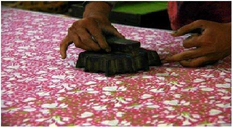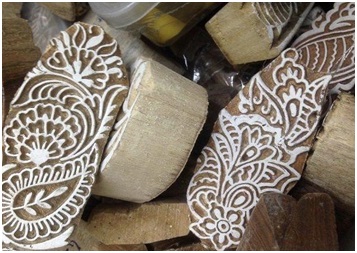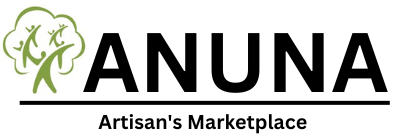Block Print

One of the most popular forms of hand printing is - Block printing. Block printing is a method of printing textiles by stamping ink-dipped blocks, made of wood or linoleum, onto fabric. This technique is one of the oldest and simplest ways to create custom fabric. It’s a more versatile and sustainable technique, lends itself well to small bespoke developments as well as large scale productions.
As a method of printing on cloth, the earliest surviving examples from China date to before 220 AD. Woodblock printing existed in Tang China during the 7th century AD and remained the most common East Asian method of printing books and other texts, as well as images, until the 19th century. Ukiyo-e is the best-known type of Japanese woodblock art print. Most European uses of the technique for printing images on paper are covered by the art term woodcut, except for the block-books produced mainly in the 15th century in India.
Prior to the invention of woodblock printing, seals and stamps were used for making impressions.

BLOCK PRINT HISTORY & EXPANSION IN INDIA
Block printing originated in China, however, it was only in India where hand block printed textiles reached their highest visual expression and commercial potential.
Block printed textiles have embedded within their fibers a rich cultural history shaped by tradition, conquest, colonization, trade, technology and entrepreneurship. They are part of a vibrant visual and material culture that has imbibed a multitude of influences over several centuries to evolve into its current unique manifestation and identity.
According to Anuradha Kumra-Chief of product(apparels), Fabindia, The recorded history of block printed fabrics dates back to the Indus Valley civilisation, around 3500 to 1300 BC. From the Harappan period onwards, the export of textiles, especially cotton, is confirmed. During the Mohenjo-daro site excavation, needles, spindles, and cotton fibres dyed with Madder (a red dye or pigment obtained from the root of the madder plant) were excavated. This proves that Harappan artists were familiar with Mordants (dye fixatives). However, Kumra believes it was only under the Mughal patronage that block printing flourished in India. “The Mughals introduced the intricate floral motifs that are still widely used in the hand block printed textiles from Rajasthan,” she says.
According to designer Punit Balana, printing and dyeing of fabrics like cotton originated in Rajasthan, and was then adapted by Gujarat. Today, the art form is practiced in the states of Andhra Pradesh, West Bengal, Punjab, Madhya Pradesh, Uttar Pradesh and Maharashtra. The famous centers in Rajasthan are the cities of Jaipur, Bagru, Sanganer, Pali and Barmer, and the state is known for its colorful prints of gods, goddesses, humans, animals and birds. While Bagru is renowned for its Syahi Begar and Dabu prints, Sanganer is famous for its Calico prints and Do Rukhi prints. Barmer is known for its prints of red chilies and trees featuring a blue-black outline, while Sikar and Shekhawat prints feature motifs of horses, camels, peacocks and lions.
In Gujarat, the well-known centers are Dhamadka, Kutch, Bhavnagar, Vasna, Rajkot, Jamnagar, Jetpur and Porbandar. Kutch's popular motifs come in red and black designs of women, animals and birds.
Punjab's Chhimba community, which is a group of textile workers, use a print with floral and geometrical motifs in light pastel hues. And West Bengal's Serampore is known for using vibrant patterns in their block prints.
Beautiful Apparels In Block Printing

Bamboo Toothbrush Covers In Block Printing

TECHNIQUES OF BLOCK PRINTING:
1) Discharge Printing-
Firstly the fabric on which printing is to be done is dyed. The dye is removed from the part of fabric on which designs are to be made by use of a chemical. Then those segments printed are treated so that they can be re-colored.
2) Direct Block Printing-
The fabric used here is either cotton or silk. The cloth is first bleached, and then dyed with the desired color. After that block printing is done on borders with carved wooden blocks then inside the borders.
3) Resist Printing-
In this technique the part of the cloth which is not to be dyed is covered with the paste of resin and clay. Then the fabric is dyed with the desirable color, at this stage the dye penetrates through the cracks which create a wavy effect of colors on the cloth. After this the fabric is finally block printed.
POPULAR BLOCK PRINTS:
- AJARAKH- These textiles featured geometric and floral patterns. The name is derived from ‘Azrak’ the Arabic word for ‘Blue’, as indigo blue happens to be one of the predominant colors in Ajarakh printing and it is one of the oldest printed fabrics known to man. They originated in the very ancient Mohenjo-Daro civilization, and the legacy has carried on ever since. This print uses motifs in intense colors like Black, yellow, crimson red, green and indigo blue (Blue and red are the most prominent and distinguishing colors of this print) and will also have motifs worked in white (unprinted) and black, usually as outline – the white and black defining the design. Ajarakh cloth is block printed by stamps on one or both sides. Wooden blocks engraved in geometric shapes and patterns are dipped in natural dyes and used in this process. Usually multiple colors are seen in the same fabric, with many different types of motifs, including border prints. Ajrakh has become a symbol of the Sindhi culture and traditions. This cloth was mainly used for turbans, lungis, shoulder cloths, women skirts, stoles etc. Ajarakh cloth kurtas are in vogue but you’ll also find bed sheets, pillow covers and tablecloths in this fabric.
- BAGH- Bagh is a unique style of block printing on handloom fabrics, the name coming from its origin in the current form in Bagh village of Madhya Pradesh, India. Practiced on natural colours of Red and black, it is usually made on a white background. Also, the chemical properties of the Bagh River are used to get unique shades. The Khatri population who migrated from Sindh were the first to introduce this art of printing. The Bagh art of dyeing and printing takes its inspiration from popular monuments such as the Taj Mahal and from nature. Geometric designs in vibrant colours are often seen in the main motif. Bagh prints mainly consist of Flowers and floral patterns. Geometrical Patterns are also popular. The process includes the use of geometric designs and bright colours, and the chemical properties of the river are used to the maximum benefit to obtain the most unique shades. The fabric after removal of starch is made to undergo what is known as the “Bhatti process” which includes boiling, drying and subsequently printing. Since cotton was the main cloth being used, these fabrics are very light and comfortable.
- DABU- Dabu is a resist technique used to create light coloured designs on a dark background. Dabu printing is done with the hand-block printing technique that uses the dabu paste (black clay) as the resist medium, made from clay, saw dust and guar gum. Dabu or daboo originates in Rajasthan and has survived the test of time with some difficulty and is a time-consuming printing technique involving many phases and a great amount of labour. Supposedly, Dabu printing originated in China and eventually, Rajasthan became the most popular centre of it. Plants, flowers and different motifs are core components of this kind of block printing. It's process involves phases of washing, hand printing, use of mud resist and drying. To concise, when the fabric is dyed, the places where the clay is applied and dried remains uncoloured.
- BATIK-Batik is an ancient art which uses wax and dyes to create a visual magic on fabrics. It is believed that the term is a derivation from the word `Ambatik’ which when translated literally stands for a piece of cloth with small dots or writing with wax or drawing in broken lines. It is a wax resist dyeing technique.Beautifully intricate as well as shaded designs can be printed on the fabric using this technique. Batik is produced in parts of Gujarat, Rajasthan, West Bengal, Andhra Pradesh and Madhya Pradesh. Its origin is attributed to being somewhere in the Middle East, Egypt and parts of Asia. Batik is a form of tie and dye method, this kind of prints revolve around selective soaking of cloth in a colour and preferentially printing it using wax. Popularly identified by little dots, this craft holds a special place in the hearts of Indian artisans as well, who for ages have been designing and giving this craft a taste of their own. Because of the enormous scope of designing patterns, this craft provides an artistic freedom to the craftsmen.It is dominated by floral patterns in earthy colours, with occasional use of bright shades. A Batik creation involves 3 basic steps – waxing, dying, and scraping ( removing). Overall the process is one where firstly the wax is used for creating designs on certain predefined areas on the fabric. Secondly, the fabric is dyed and then the wax is removed by scraping or by boiling the cloth so that the wax peels off. The result is a beautiful piece of cloth with some very unconventional designs.
- KALAMKARI- Kalamkari is an ancient style of hand printing which originated in the state of Andhra Pradesh, that is done on cotton or silk fabric with a tamarind pen used with natural colours extracted from fruits and plants to dye the cloth. Kalamkari is a mix of hand paintings coupled with Hand Block Printing. The word is derived from a Persian word where ‘Kalam’ means pen and ‘kari’ means craftsmanship. The motifs of Kalamkari are mostly flower, peacock, paisley along with divine epics of Ramayana, Mahabharata used as primary themes, and this art form depicts India in all its past glory. In earlier days, singers, poets and scholars used to paint accounts of stories from Hindu mythology which ultimately led to the generation of kalamkari prints. Referred to as ‘Chintz’ by the english and ‘Pintadoes’ by the Portuguese, Kalamkari was patronized by both Mughals and later by the Europeans in India. It has been practised by families and generations over the ages. The art developed in and flourished in the Machilipatnam region with the main centre being Pedana (Andhra Pradesh). This art primarily uses Earthy colors like Indigo, mustard, rust, black and green. Natural dyes are used to paint, these colours are extracted from natural sources with no use of chemicals and artificial material. Apart from cotton, base materials like raw silks, chiffon and georgettes etc are also being used now. Motifs have also been contemporised with addition of new natural forms and stylised figures. New colour schemes of pastels, neutrals like brown, beige, maroon etc have been added to the traditional colour story. It’s process involves 23 tedious steps. From the natural process of bleaching the fabric, softening, sun drying, preparing natural dyes, hand painting to the process of air drying and washing, the entire procedure requires precision and an eye for detailing. After stiffening and drying the cloth, it is printed in different phases according to the colour scheme. Wax is used while dyeing the areas blue and the remaining areas are hand painted. A bamboo stick with a bundle of fine hair is used as a brush while painting. The fabrics printed at Masulipatnam are used as furnishings such as bedspreads, curtains, table cloths etc apart from apparel like kurtas, sarees and dupattas.
- SANGANER- Sanganer on the outskirts of Jaipur is a large centre for printing on fabrics.The Sanganeri hand block-printing industry is blessed with natural factors that support it, like water, sunshine, atmospheric humidity and the local herbs and flowers used in the printing process.Today, Sanganer is filled with block makers and printers. Sanganeri Hand Block Prints are famous for their off white or pure white backgrounds. The designs are very intricate with fine lines with detailing.Beautiful floral designs with buds, flowers, leaves, petals, almonds, mangoes and even jhumkas sometimes are part of the detailed designs on the blocks.The colours are usually red and black with occasionally violet. The floral and leaf motifs of roses, lilies, marigold , sunflowers and lotus are complemented by geometric motifs. The outlines of the motifs are clearly and delicately printed first and then the colour is filled in. The patterns of floral motifs, are known by the names of the plants. Both vegetable based and chemical dyes may be used for Sanganer Hand Block Printing. Sanganeri print bed sheets are pretty famous. The block printing is done mainly for products such as saris, dupattas, salwar kameez, bedcover, curtains, scarves and other home decors.
- BAGRU- Bagru is one of the most well known hand block printing styles from Rajasthan, this printing technique is laborious but produces exquisite results. It’s traditional processes of hand block printing on textiles with rich natural colours have been known for many centuries. The process is a long and cumbersome one that requires the “Chhipa” or the Printer to be exceptionally skilful as well as patient. “Chhipa” is the local word that refers to the printer as well as the community that is engaged in this craft. This technique has been developed by families and handed down traditionally in Rajasthan. Bagru block printing has been alive for centuries creating some of the best Indian prints. A tediously long process that involves creating wash resistant prints, the craft boasts of master craftsmen who have been dedicated to it for a long time. Patterns in rich colours like indigo blue, alizarin red, iron black and bright yellow colours are produced on coarse base fabric which is generally cream or yellowish in colour by indigenous processes of dyeing and printing. In building up patterns geometrical forms were adopted along with floral animal and bird forms.Bagru designs consist of various types of designs that include Birds, Fruits, Leaves, Animals and geometrical shapes. Another popular design in Bagru is that of intertwined lines or “Jaal”. The styles and motifs have been adapted to some extent to the changing markets. Washing, hard dyeing, drying and other parts form the core of the printing process. Blocks are placed from left to right and slammed hard on the fabric. The fabric is dried afterwards. They are then washed and boiled and finally rinsed to get the final product.The brightly coloured block printed fabrics from Bagru are used for apparel as well as home furnishings such as quilts, bedspreads, cushions and curtains.
- GOLD & SILVER DUST- A traditional form of printing, ‘Chandi Ki Chhapai’ or ‘Silver Printing’ is a delicate way of embellishing clothes or fabrics. Also called ‘Varak Gold or Silver Leaf Printing’, this kind of printing uses varaks made by flattening gold or silver into a thin paper-like consistency. These thin sheets of silver are also used to garnish Indian sweets. Rajasthan specialises in this kind of block printing. What is notable about this technique is the use of already printed, dyed, and finished textiles as it only involves work on the surface without much permeability. In ancient times, it was hand printed onto flags, royal tents and other insignias of power to reflect the status and prestige of the possessor.It is a popular embellishment in holy shrines and temples today. Dust of precious metals like gold and silver is used in this age-old technique to give textiles a feel of exquisite zardozi and the sparkle of gold. Small dots, flowers, petals and dashes comprise most designs.Over the ages, the technique has adopted the use of more affordable metals like mica and chamki. In it’s process, a roghan gum paste with castor oil is used. Two different blocks are used, and through perforations, the gum paste is squeezed in a pattern on the textile. Then the metal dust is sprinkled on top of this to add the necessary amount of shine and glitter.The technique of varak block printing is extremely rare today and there are only few printers who do this in Jaipur (Rajasthan). Today, silver and gold leaf printing can be seen on rich Chanderi sarees and dupattas, done by some of the finest craftsmen in the country.
In India, hand printed textiles have always been favored by the urban elite and there is a strong niche market for these textiles. Nowadays, environment-friendly production and the resurgence of craft as an antithesis to the alienation felt by industrialization have all served to revive the block printing industry.
For India, block prints hold a place of pride, the age-old craft of dyeing and colouring a fabric using wooden blocks has been perfected over generations. Whether it is Rajasthan's popular Dabu print, or Gujarat's Ajrakh, each block print is symbolic of the country's vast heritage and rich culture. India is, after all, one of the largest manufacturers and exporters of block printed fabrics, catering the needs of niche markets and textile connoisseurs worldwide.
 1,12,000 Artisans families benefited so far
1,12,000 Artisans families benefited so far
